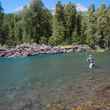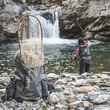It looked like our trip to Colorado was going to be canceled. The report was that the trout were stressed out and needed a break. Our first thought was heat, the usual culprit for stressed fish. Hailing from southern California, Bob and I were well aware of the ravages of drought and heat on coldwater fisheries, not only locally but throughout the U.S. as climate change continues to wreak havoc and elected officials continue to ignore it. But the year had been a mild one, and in fact the amount of snow and rainfall had been heavier than in most years. What, then, could be stressing the fish?
In the words of Jeff Poole, fly fishing guide at the North Fork Ranch, “it seems odd to think of shutting down these properties due to low flows on what looks to have been a record setting year for moisture. All I can report is that the fish are in bad health. We have lost a number of fish when releasing them. My theory is that the groundwater table is at high levels and perhaps we have above average mine seepage. And those heavier minerals are negatively affecting the fish.”
Mine seepage. Something that was not even on my radar.
It’s an understatement to say that the history of Colorado has been tightly coupled with the history of mining. Mining played a major role in the development of Colorado as a state and in the development of the entire nation, and for good reason. Colorado has an abundance of mineral riches. According to the History section of the website of the Colorado Geological Survey, “From silver and gold to globally-ranked quantities of industrial minerals and coal, Colorado has a bit of everything. Geologists and miners recognized a broad area throughout central Colorado that contained many precious minerals: the so-called Colorado Mineral Belt. This region has produced much of Colorado’s mineral wealth for many decades, beginning in the 1800s.” Targeted minerals have included gold, silver, lead, copper, molybdenum, zinc, tin, coal, uranium, beryllium, tungsten, and more. People have been after those riches since before the time that Colorado became our 38th state back in 1876.
The Colorado Mineral Belt (CMB) runs in a broad southwest-to-northeast line, extending from the San Juan Mountains in the southwest to its northeastern extent in the Front Range of Colorado just north of Boulder. The North Fork Ranch, located in the unincorporated community of Shawnee in northern Park County, is on the eastern edge of the CMB. It’s in the Platte Canyon, on the North Fork of the South Platte River. The South Platte River originates in Park County and runs northeast, roughly paralleling the entire north half of the CMB before turning east toward Nebraska. The watershed includes much of the eastern flank of the Rocky Mountains. Everything drains into it.
But abandoned mines? How serious a problem could that be today? How many abandoned mines exist in Colorado? No one knows for sure. According to a 2017 report by Jeff Graves, Director of the Inactive Mine Reclamation Program of the Colorado Department of Natural Resources, the answer is more than 23,000. That’s not a typo. More than 23,000.
And much to my surprise and dismay, many of these are on public land, land that you and I, along with everyone else in the nation, own. What’s worse is that the number of mining claims, many still active today, exceeds even this number. In Park County alone there are more claims than there are abandoned mines in the entire state. “Park County, Colorado, has 28,884 records of mining claims on public land managed by the Bureau of Land Management and 591 records of mines listed by the United States Geological Survey (USGS)” (emphasis added).
Upon learning this, I was stunned. How could this be true? How could public land, owned by all of us, be absolutely peppered with abandoned mines leaking poisons into our rivers? Who approved this bizarre system whereby any yahoo who wants to dig for gold – and this includes foreign mining companies – can desecrate and poison vast acres of public land for a handful of dollars and with little or no responsibility to clean it up afterwards? The answer lies in the history of mining itself, and specifically the General Mining Law of 1872, created by president Ulysses S. Grant to promote the settlement and development of publicly-owned lands.
“The 1872 mining law that governs minerals on federal land allows anybody to stake a claim for as little as $2 an acre without paying royalties for minerals and gives the government little authority to stop mines. Soaring gold and metal prices have led to a new rush on minerals. Mining built many Western towns, but tourism and retirees now make them tick, and many doubt the past and present can co-exist,” R. Scott Rappold wrote in the Colorado Springs Gazette.
You likely will not be surprised to learn that the damage caused by these mines is severe and long lasting. According to the Colorado Geological Survey, “Acid mine drainage (AMD) is water that is discharged from mining or mine-related operations, which contains high levels of dissolved metals and sulfates in conjunction with pH values less than 4.5 (acidic). AMD is formed from the reaction of various minerals (principally pyrite) with oxygen and water. AMD can degrade the water quality of streams and water supplies, often to the point of causing harmful effects to the aquatic life of the stream.” A report from the Environmental Protection Agency indicates that 40% of the headwaters of all western U.S. watersheds have already been polluted by mining.
Just north of us, in Wyoming, the Wyoming Department of Environmental Quality has issued this dire warning about abandoned mines: “Blasting caps, dynamite and chemicals were often left behind when the workings were abandoned. Explosives become unstable with age and can be detonated by the vibration of footsteps. Abandoned chemicals such as cyanide, arsenic, mercury and other deadly toxins may be present in leaking and deteriorating containers. Lethal concentrations of methane, carbon monoxide, carbon dioxide and hydrogen sulfide may accumulate in underground passages. Oxygen deficient air may cause suffocation. People have died within a few feet of mine openings.”
Not all of the mines in Colorado are in locations that could negatively affect the South Platte River, but thousands of them are. All abandoned, all toxic, all leaking, and all upstream. In the first quarter of the 21st century, many of our rivers and streams are suffering the impacts of horrendous environmental policies stretching back nearly 150 years.
At my age, I have plenty of scars, some worse than others. Some from surgeries, one from a .38 caliber bullet that missed its target, several from assorted accidents, a couple of small ones even from fly fishing. Anyone who manages to live six decades has them. And I can live with them. These scars will not be passed on to my children, nor to my children’s children. They are reminders of pain in some instances, of certain trips or events, of mistakes in some cases, of our amazing ability to heal. But they will not be here when I am gone.
On the other hand, if I allowed myself to support the Keystone XL pipeline (sending Canadian oil through the middle of the U.S., crossing streams, rivers, and habitats known to harbor endangered species [January 2017]), removing a rule that prevents mining companies from dumping waste from mountaintop removals directly into streams [February 2017], decimating protection for marine habitats and wildlife [April 2017], repealing the Clean Water Act that protected headwaters, wetlands, and other bodies of water [June 2017], rolling back a 20 year ban on mining near the Grand Canyon [December 2017], opening the Arctic National Wildlife Refuge to oil and gas exploration [December 2017], reducing the size of established national monuments [February 2018], overturning a moratorium on new coal leases on federal lands [September 2018], gutting the Endangered Species Act [February 2019], rescinding the ban on selling bottled water in our national parks [June 2019], renewing Chilean-owned mining leases in Superior National Forest that endanger the entire Boundary Waters Canoe Area Wilderness [July 2020], or weakening protection for migratory birds [November 2020] — all of which were proposed or enacted by the Trump administration — then my children, and my children’s children, and their grandchildren, and yours, would have to live with that. Those scars would be a part of their lives.
In the fall of 2020, the U.S. finally rid itself of the most environmentally insensitive administration in the nation’s history. Those that disagree with that statement are simply uninformed, and no amount of arguing or bluster or intimidation or fake news will change it. Over four years, more than 100 environmental protections for air and water pollution, biodiversity, and climate change were gutted. The environmental setbacks and damages of the Trump administration have been chronicled extensively in other places, including Hatch Magazine.
But the Trump administration was not the first, nor will it be the last, to propose disastrous policies or to weaken good ones that offer protection to trout and other wildlife. Nor is this blame confined to a single political party. The Biden administration, eagerly anticipated by environmentalists as a panacea for the previous four years, has been far less than the salve voters hoped for; indeed, the new administration has failed as well, continuing to greenlight fossil fuel permitting and leases on public lands, and even expanding offshore drilling. An article by Emily Holden in The Guardian in February 2022 pointed out that the new administration, in only its first year, (1) held the biggest-ever offshore oil drilling lease sale in the Gulf of Mexico, (2) permitted more drilling on public lands in the West and in Alaska than Trump did in his first year, (3) failed to advance a climate legislative agenda, and (4) faltered in quickly reinstating rules. The truth is that no administration, and neither political party, has tackled threats to our environment, and in particular the issue of toxic mines, with the urgency that it demands.
In the months leading up to the 2020 elections, I was occasionally asked by fellow fly fishers why I was so adamant about voting out the current administration. After all, in a two-party system, the pendulum always swings back and forth, so what would be the problem with another four years of the Trump administration? Why, I was asked — and saw repeatedly on the Trout Unlimited Forum blog — can’t we just leave politics out of fly fishing? It’s because of the lesson of the abandoned mines. What we do now, today, can have serious repercussions for years to come, and some of the damage cannot be reversed. Ever.
So many of our mistakes can be corrected that sometimes we forget, or ignore, the ones that cannot be. Bad laws can be removed from the books. The election of an inept president can be corrected in the next voting cycle. Even a stacked supreme court can be balanced again, eventually. But if you screw with Mother Nature, there’s an excellent chance that she will never be what she was—at least, not in our lifetimes. If you sell public lands to the highest bidder, they may never again be available for our recreational use, whether it’s fly fishing, camping, hunting, hiking, bird watching, or any other pursuit. They are, quite simply, gone. If we had turned a blind eye and allowed the Pebble Mine to go forward — a fight which, despite recent victories, could still be in our future— Bristol Bay and the largest salmonid migration in the world would have been changed forever. Although mitigation efforts can have amazing results, you cannot un-poison a stream. You cannot un-dig a mine. Because of Ulysses S. Grant, I will never live in a world that does not have abandoned mines leaking toxins into local waters. Neither will my children. Or my grandchildren. Or yours.
There are scars that are permanent, and from which we cannot recover. As protectors of trout and the environments in which they live, it is our duty to prevent them. And just as it is with our bodies, the solution is to avoid the injury to begin with rather than figure out ways to live with the scars later.
Bob and I caught a load of trout that week, including his largest brown and my largest rainbow, both on dry flies. Other nearby streams, even including other sections of the North Fork and the stunning Eleven Mile Canyon, did not seem to be affected by whatever was bothering the trout of the North Fork Ranch that summer. The fishing was great, and Colorado lived up to its reputation as a state of legendary beauty and riches. We left feeling like those treasures are worth fighting for.































Comments
Kimball Leighton replied on Permalink
One of the best-written and most authoritative magazine articles on trout fishing vs. abuses of the notorious 1872 Mining Act. Dr. Martin's piece is straightforward, well researched and convincing. Trout waters compromised by mine runoff are far from unique to Colorado. Montana, where I live, has more than its share and spineless state agencies to clean up abandoned sites and prevent others. Thanks Doc!
Jody replied on Permalink
Hi everyone,
I'm really sorry to be so slow seeing and replying to these comments -- I've been traveling and not checking my email and websites.
Thank you all, sincerely, for the very kind words! I'm delighted that you liked the story. Hopefully it will not be too long before something can be done about this very large and serious problem. Thanks again, very much.
Jody
Anonymous replied on Permalink
Thanks so much, Kimball!
Doug Christ replied on Permalink
Dr Martin, I am impressed, thankful and jealous of your work. I am also concerned about the fractured orphaned oil & gas well casings that allow contamination of underground water.
Anonymous replied on Permalink
Thank you, Doug! I share your concern about the oil and gas, and hope others do too.
Andrew winton replied on Permalink
Hear hear
Timothy Zilinsky replied on Permalink
Very well written and extremely informative. I knew there were and still are a lot of mines across the west but had no idea there were so many abandoned still poisoning the planet. Until the outdated laws are change and adapted to current times, things will never change. One thing to keep in mind is that mines are essential to our modern way of life. Without the minerals produced we could not have this conversation. No computers, no cars and certainly no electric vehicles! No cell phones. In fact everything that exists pretty much today utilizes some type of mineral that has been mined. I've been a fly fisher for over 50 years and I am disheartened by the demise of so many of my favorite rivers but we do need mining and unfortunately past mining has cast a mindset of disaster on todays mines. New mining technology is making the process safer for the environment but people refuse to except that because of the past and history is impossible to change but we need to get more educated on what can be or we will all go back to riding horses to get to our next fishing adventure!!!
Anonymous replied on Permalink
Thanks Timothy! You're right of course, we certainly do need the minerals that mines produce. But there has to be a way to extract them in a more responsible manner, and with accountability to clean up afterwards! Let's hope others agree!
Timothy Zilinsky replied on Permalink
Mines have changed their methods and accountability for what they leave behind. Unfortunately the past is difficult to forget and that overshadows companies that are being more environmentally conscious with the way mines are operated. If people and organizations actually took the time to see what has changed with modern mining operations and not just picture past failures, I think they would be more open to what is being done today. I agree it isn't perfect but it is much better and they continue to improve.
Pages